The Caiman Lizard is a semi-aquatic reptile from the rainforests of South America.
Caiman species are unique for their large crocodilian-like scales.
This leads to many people thinking that they are related to crocodilian caimans.
Caiman Lizards are actually cousins of Tegus. Because of this they are agile on land, in trees and in water. Enthusiasts can spend hours watching them climb, swim and dig.
To keep this species as a pet you must be prepared. They need lots of space, care and time.
Keep reading to learn about this species, common husbandry mistakes and how to care for them.
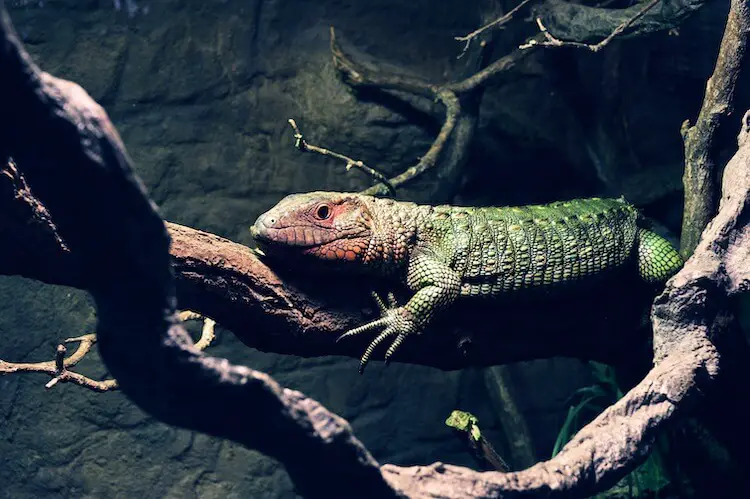
What Is A Caiman Lizard?
Caiman Lizards are a species of reptile from the Dracaena genus. They live along the Amazon River Basin in South America. It is common to see them in countries such as Brazil, Colombia, Paraguay, Peru and Ecuador.
There are three known subspecies of Caiman Lizard:
- Northern caiman lizard (Dracaena guianensis) – the most popular pet species.
- Paraguay caiman lizard (Dracaena paraguayensis).
- Dracaena colombiana (now extinct) – discovered in 1961 via fossils found in Colombia.
The northern caiman was first discovered in 1802. Its natural range includes much of northern South America. Northern subspecies tend to have to the most vibrant coloration. They have bright orange or red heads and bright green bodies with darker banding. Their body can range from muted to bright green and their tails are a muted brown.
Paraguay caimans were first discovered in 1950 and their natural range includes Paraguay and Brazil. They tend to be less colorful with grey or tan heads and bodies.
Northern and Paraguayan subspecies both have muscular bodies and powerful limbs. This helps them with swimming, climbing and digging.
Owners can enjoy hours of entertainment as they watch their colorful lizard swim and explore their enclosures. They are a very active reptile and will utilize branches for climbing, the water area for swimming and substrate for digging.
Caiman Lizards have tough raised scales for protection from predators. Their large crocodilian-like scales lead to many people thinking they are related to crocodilian caimans.
Caiman Lizards are actually cousins of Tegus. They are even known as water Tegus!
What We Like About Caiman Lizards
Pros
- Their body ranges from muted to bright green and their heads are vibrant red or orange.
- Not naturally aggressive.
- They develop individual personalities and can form a bond with their owner.
Cons
- Adults measure two to five feet so need a large enclosure.
- They need a specialized diet of aquatic snails.
- Produce large amounts of waste.
Species Appearance
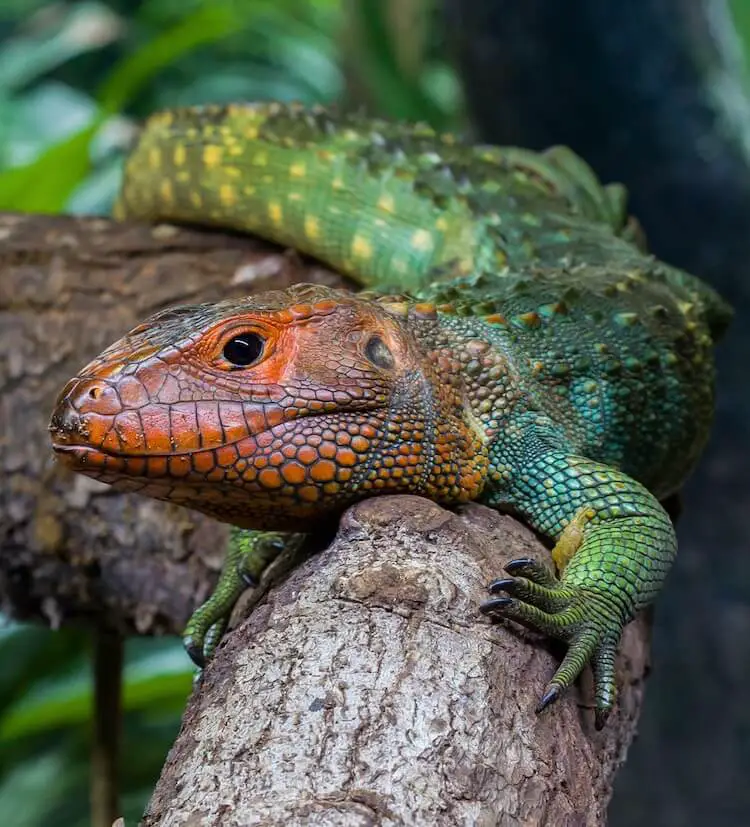
Caiman lizards share many characteristics with Tegus and Crocodilian Caimans.
They are a semi-aquatic species that has a very long tail. This flattened tail is very powerful and helps them to move through water with ease. It can range from brown to black topped with yellow stripes.
This species has strong bodies and limbs that make climbing branches very easy.
Northern caiman lizards are more vibrantly colored than the Paraguay species. Their bodies are striped with dark and light green and their heads are a vibrant orange or red. Males tend to have slightly broader and more vibrantly colored heads.
Paraguayan individuals are less colorful. They normally are grey or tan.
Both species have forked tongues and strong jaws that are lined with short rounded teeth. Their teeth are perfectly suited for their diet of snails and shellfish.
Adult Caiman Lizard Size
Caiman Lizards are one of the largest lizard species in the Americas. Full grown Caiman Lizards weigh between eight and twelve pounds. Females grow up to four feet in length and males are slightly larger at five feet.
New-born hatchlings measure just five inches in length but grow quickly. They can grow to over two feet in length after one year.
As one of the largest lizards of the Americas they require a very large enclosure. The challenge of taking care of this species attracts many experienced enthusiasts.
Caiman Lizard Care Sheet
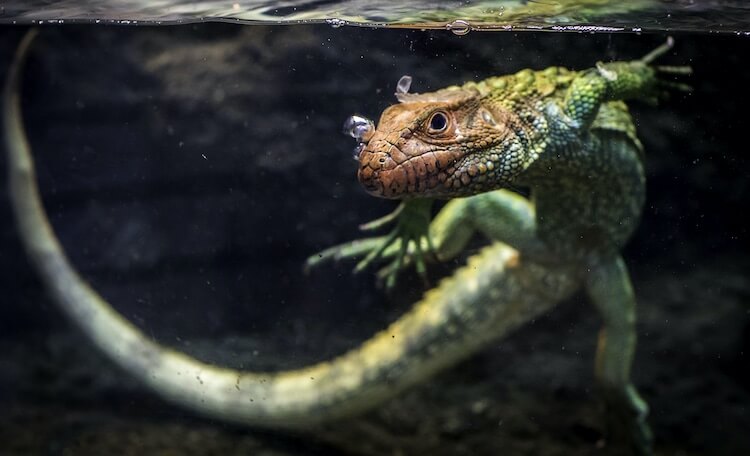
Caiman Lizard Diet and Feeding Guide
Caiman Lizards are semi-aquatic carnivores.
In the wild they hunt underwater and eat a diet primarily consisting of snails, shellfish and hard-shelled invertebrates. There have even been accounts of them eating Amazon river turtles!
This species has molar-like teeth and strong jaw muscles that allow them to crush hard-shelled invertebrates at the back of their mouths. They then spit out the broken shell and eat the digestible portions.
In captivity this species should be given a diet of hard-shelled invertebrates.
Snails, crawfish and freshwater clams are all good prey items:
- Young caimans should be fed a few small-sized snails from a feeding bowl.
- Juveniles (1 and 2 years) can be fed medium-sized prey items each day.
- Adults can be fed a few large-sized prey items every few days.
At times their diet can be supplemented with super-worms, crickets and tropical fruits (e.g. bananas, mangos and kiwis).
Caiman lizards also need plenty of water. They will use this water for swimming and hydration. A large area of freshwater with a minimum depth of 12 inches should be provided in their tank (more on this in the setup section below).
Lifespan and Health Concerns
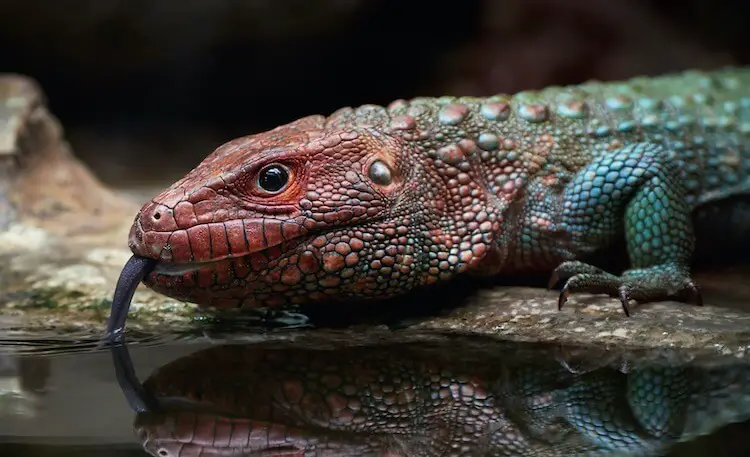
Caiman Lizards can live for over 10 years in captivity. Many health problems can be avoided through proper care and habitat maintenance.
When your reptile first arrives home you should give him lots of time alone. This will help him to adjust to his new environment. He will spend his first few days climbing, basking on branches, swimming and digging.
Lethargy can be quite common during their first week. It usually goes away as they become more familiar with their habitat. If lethargic behavior continues for much longer than a week then check the enclosure’s temperature, lighting and humidity.
Anorexia can also occur with lizards who have not adjusted to their new diet or habitat.
Newly adopted caimans may take between three and seven days to begin eating.
Eye and ear infections can occur frequently with this lizard due to their semi-aquatic nature. Maintaining high water quality through adequate cleaning and filtration is the only way to avoid these infections.
- Reddening of the eye, scratching or itching, and using only one eye are all possible signs of an eye infection.
- Bulging around the ear and rubbing at one ear are signs of an ear infection.
If your lizard has an infection you will need to drain the water from their habitat to allow the wound to heal.
Caiman Lizard Enclosure
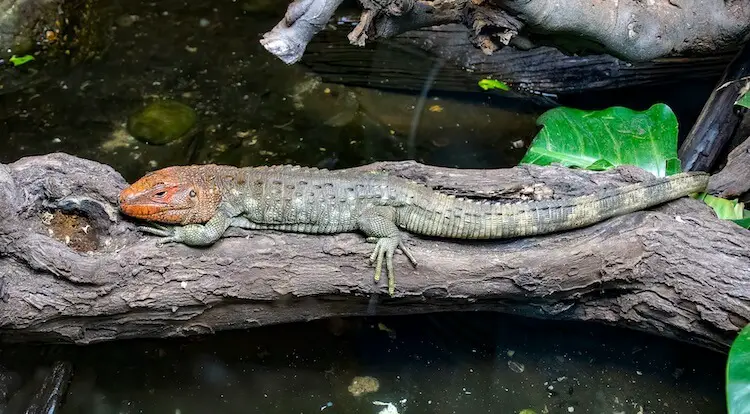
This lizard is found throughout the Amazon River Basin of South America.
They enjoy the wild, lush and moist ecosystems of swamps, flooded woodlands and marshes. These ecosystems perfectly suit their semi-aquatic lifestyles as they have plenty of water to swim and forage in, while also having low-hanging branches for basking.
You must replicate these conditions when you keep a pet Caiman Lizard.
It is very important you maintain the right temperature and humidity.
Their enclosure should be kept between 80 and 90°F with a basking area at ~105°F. Humidity should be kept between 60 and 80%.
This temperature gradient can be achieved through a ceramic heat emitter and spot lights. Their enclosure should have a 14 hour light cycle of UVA, UVB and visible daylight.
Caiman Lizard Setup
A large enclosure is a must for Caiman Lizards.
Juveniles can live in a 55-gallon terrarium but adults will need an enclosure that is at least 6 feet long, 3 feet wide and 4 feet tall. Their enclosure should be big enough for a large water area and also have both land area and vertical space for climbing.
- Tank Type: glass.
- Tank Size: 500-gallon.
- Lighting: UVA, UVB and visible daylight.
- Substrate: mix of cypress mulch, earth substrate and clean sand.
Their enclosure should have a large water area that is at least one foot deep. It needs to be deep enough for your caiman lizard to be completely submerged. The water should be kept clean with a large aquarium filter and will need to be cycled multiple times each week.
The setup should also have lots of land area and vertical space for climbing. To incorporate both land and water you will need to divide the floor of the enclosure in half.
When filling the dry portion of the enclosure a substrate mix should be used.
A substrate mix consisting of cypress mulch, earth substrate and clean sand is best as it will help to keep the humidity above 60%.
You should also provide a variety of strong branches for climbing and basking. Large cork branches and Mopani make great basking areas. Make sure the branches are secure so they don’t give out under the weight of your lizard.
The destructive habits of caiman lizards (e.g. digging and climbing) make decorating the enclosure difficult. Hardwood tree branches or artificial plants can be used. Live plants should be avoided.
Once every couple of weeks the enclosure should be deep cleaned.
Wipe down all cage surfaces with herp-safe terrarium cleaner and wash removable decorations and non-disposable substrate using reptile-safe soap and water. Be sure to rinse everything thoroughly with water to avoid exposing your caiman lizard to chemical residue.
Typical Behavior
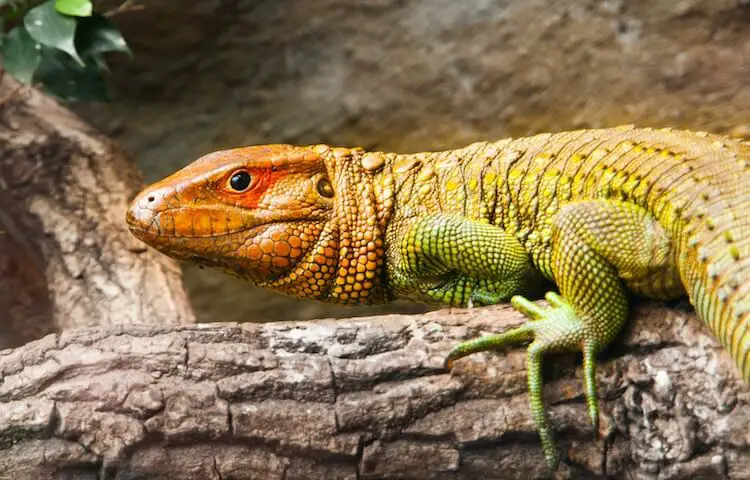
Caiman lizards are almost always found near a water source. They spend a lot of time soaking in shallow waters and hunting for their aquatic prey (e.g. snails and crawfish). It is also normal to see them basking on low-hanging branches above water. At the first sight of danger they will drop down from these branches and swim away.
They will perform these same behaviors as a pet.
Once settled in their enclosure they will spend a lot of time swimming, climbing and digging.
This species is neither solitary or social. They can happily live alone and are peaceful around other lizards. Caimans are not typically aggressive or territorial.
However, if this lizard feels scared or threatened, they can lash out with a bite, scratch, or tail whip.
Handling Advice
Caiman lizards are like Bearded Dragons with their easy-going temperament.
Establishing trust when they are juveniles is important. To do this you should give your lizard lots of time to adjust to their new environment before handling.
Initially juveniles may huff at you and run away. Once this behavior stops you can begin handling.
Try and limit handling to just a few minutes when you begin. When handling make sure you observe their comfort levels so you do not stress them and avoid jerky or abrupt movements.
Baby Caiman Lizard
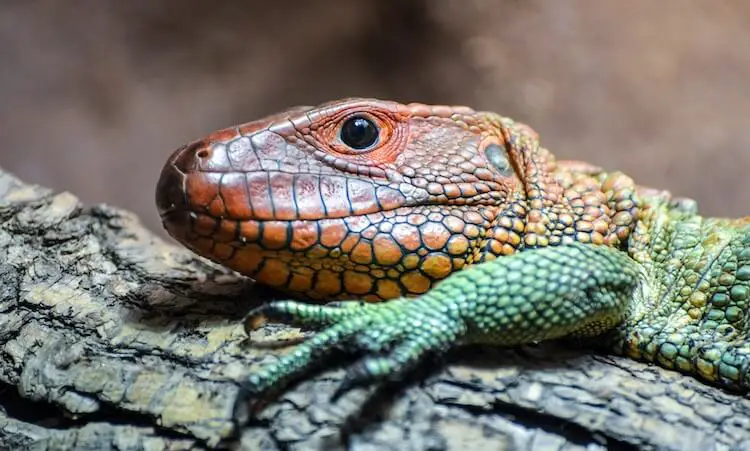
This lizard is an exotic pet.
They are primarily sold by specialized reptile breeders and are priced between $350 to $1,500.
Remember only the Northern caiman lizard is sold as a pet. Do not purchase a wild caught Paraguay individual.
When looking for caiman lizards make sure to check for lethargy, crusting around the eyes and mouth and any protruding bones (especially around the hips). These are all signs of an unhealthy lizard.
Young healthy juveniles will have lots of energy and huff or whip their tail if you try and handle them.
| Caiman Lizard Facts | |
|---|---|
| Common Names | Caiman Lizard, Northern Caiman Lizard, Paraguay Caiman Lizard |
| Scientific Name | Dracaena guianensis, Dracaena paraguayensis, Dracaena colombiana |
| Price | $350-$1,500 |
| Size | 4 feet (females) and 5 feet (males) |
| Weight | 8 – 12 pounds (males are heavier) |
| Lifespan | 10 years |
| Diet | Snails, Shellfish |
| Tank Size | Minimum 10-gallon |
| Humidity & Temperature | Basking: 100 – 105°F Temperature: 80 – 90°F Humidity: 60 – 80% |
| Popular Alternatives | Savannah Monitor, Asian Water Monitor, Rhinoceros Iguana, Argentine Tegu |
Care Guide Summary
The Caiman Lizard is a semi-aquatic lizard from the Dracaena genus.
There are three subspecies in this genus but only the Northern caiman lizard is kept as a pet.
Keepers love this reptile’s vibrant colors, unique personality and busy nature. Caimans love climbing, swimming and digging.
There can also be lots of enjoyment in the husbandry of this species. But, Caiman Lizards should only be kept by experienced reptile keepers.
Their complicated tank setup requires both dry and wet areas. This is a big commitment even for advanced keepers. Purchasing and keeping them will also cost you thousands of dollars. Be ready for plenty of work!
If you are thinking of taking on this lizard then let us know in the comments.

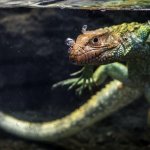
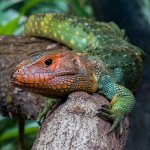
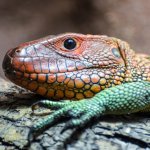

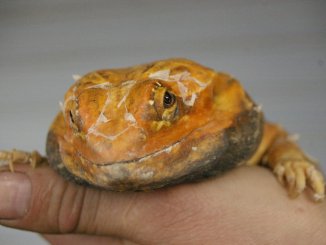
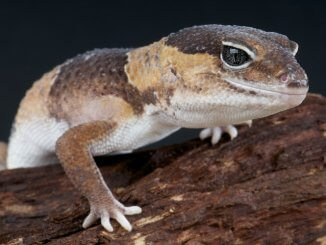
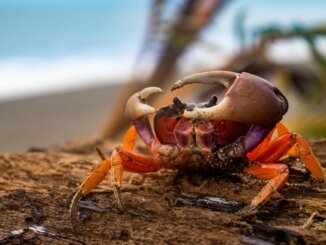

Very good read. Thank you.